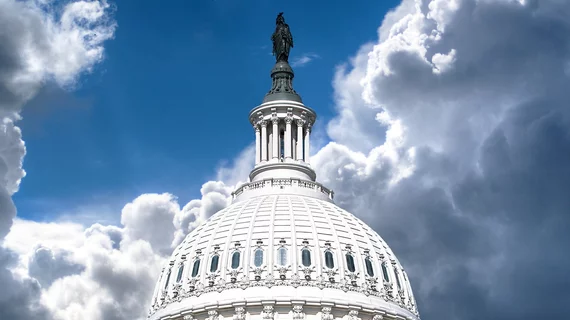Congress reaches deal to partially blunt Medicare pay cut, ditches prior authorization reform
UPDATED Dec. 23: Lawmakers have now ditched the previously agreed-upon deal and on Dec. 20 passed a slimmed-down version at the urging of President-elect Trump.
Congress has cut a deal to partially blunt the physician Medicare pay cut set to take effect on Jan. 1.
Lawmakers on Tuesday revealed the continuing resolution to avert a government shutdown, which includes several provisions related to healthcare. Chief among them is a 2.5% temporary payment increase under the Medicare Physician Fee Schedule “to account for exceptional circumstances,” according to the bill text.
Without congressional action, radiologists and other physicians are slated to face a 2.8% cut to the conversion factor used to calculate payments. The Medical Group Management Association on Tuesday expressed frustration that lawmakers are not proposing to completely reverse the reduction.
“We are deeply disappointed that Congress failed to fully remedy the looming 2025 Medicare payment cut to physician practices. Any cut, however fractional, is unacceptable,” Anders Gilberg, senior VP of government affairs for the MGMA, which represents over 15,000 group practices in radiology and other specialties, said in a statement.
Radiology advocacy groups had hoped for enactment of an annual inflation-based payment increase for physicians tied to the Medicare Economic Index. This is the fifth consecutive year physicians have faced a cut in the federal payment program, and docs have seen Medicare reimbursement decrease by about 29% since 2001 when adjusting for inflation, the American Medical Association noted.
“The Radiology Business Management Association is eager to see a permanent solution to the continual Medicare Physician Fee Schedule cuts that are opposed by an overwhelming bipartisan majority of Americans and have disproportionately impacted our specialty for over a decade,” RBMA Co-executive Director, Linda Wilgus told Radiology Business Tuesday. “While we’re grateful for Congress acting to blunt some of the reduction, America’s healthcare providers are watching a slow erosion of our nation’s safety net,” she added later.
Mixed bag
MGMA labeled the rest of the continuing resolution’s healthcare provisions as a “mixed bag” for physician groups. The bill also incorporates an extension of telehealth flexibilities through the end of 2026, along with an increase in alternative payment model incentives to 3.53%.
However, the resolution does not include the radiologist-supported Improving Seniors’ Timely Access to Care Act. First introduced by senators in June, the bill would simplify how payers process prior authorization requests in Medicare Advantage. This would include establishing an electronic process, increasing transparency, and expediting decisions for routinely approved healthcare services.
Last week, co-sponsor Roger Marshall, MD, R-Kan., reported that the legislation had garnered 60 supporters in the Senate and 230 in the House. It also has earned endorsements from 500 provider and patient advocacy groups including ASTRO, the American College of Radiology, American Society of Neuroradiology, Society of Interventional Radiology, and the Association of Academic Radiology.
MGMA’s Gilberg noted that the legislation earned a zero score from the Congressional Budget Office, with no impact on federal spending, and had “little to no opposition.” MGMA believes the failure to incorporate the bill in the continuing resolution represents a “huge congressional end-of-year failure and another win for big insurance to the detriment of America's patients.”
The Regulatory Relief Coalition—which includes the MGMA and several other medical societies—on Tuesday said the legislation was “thoroughly vetted over the past seven years.” Still, lawmakers opted to “unnecessarily” begin “revisiting bill language, seeking to water down this consensus-driven, bipartisan bill.” This only served to strip away “essential transparency oversight protections that are the hallmark of this widely supported legislation.”
“This colossal failure to respond to the public outcry for better oversight and transparency of the [Medicare Advantage] program is completely unacceptable,” the Regulatory Relief Coalition said in a statement Tuesday. “The RRC commits to working with the bill champions and our broad and strong coalition to help Congress see the light on the need to act and rein in unnecessary prior authorization delays and denials. We won’t stop fighting for what we—as a driven group of patient-focused stakeholders and providers who care for them—know is right for America’s seniors.”
The Hill reported Tuesday that the continuing resolution will push the Dec. 20 funding deadline to March 14. This will give the incoming new Congress and president elect more time to hash out how to fund the federal government for the next year. The House is expected to move quickly on the bill given the Friday deadline and forthcoming holidays, The Hill reported.
The continuing resolution also does not include the Medicare Access to Radiology Care Act, reintroduced by U.S. senators on Dec. 12.

